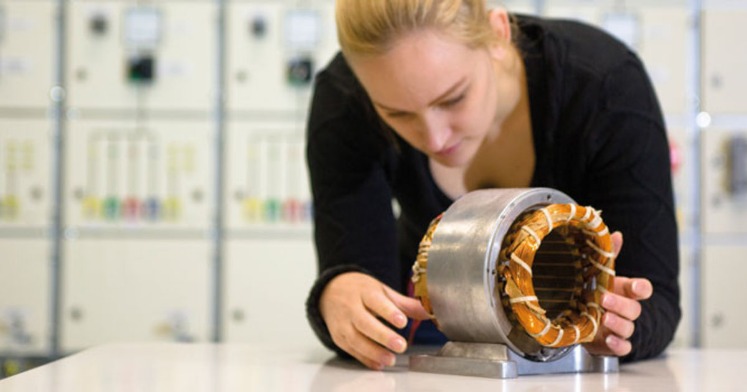Input command signal, which adjusts the working point of the drive, types an input to the management unit. Sensing of sure drive parameters, similar to motor present and pace, may be required either for protection or for closed loop operation. An electric drive (often known DKC06.3-040-7-FW as an electrical controller) is a device used to control the output of a motor used, for example, to produce linear motion in an electrical actuator. In our article on electrical motors we referred to the feedback mechanism from a servo motor, shown schematically beneath.
The hoist consists of a rope wound on a drum coupled to the motor shaft. There are two ends of the rope, on one end, there is a cage and on the other end there’s a counter weight. The counter-weight is greater than the weight of the empty cage and decrease than the load of the fully-loaded cage. When there is an upward movement of the cage, then it represents the forward course of the motor. The selection of transmission mode must therefore embrace an vitality efficiency criterion. Generally speaking, trendy direct-drive options are the most environment friendly, adopted by gears and chains. The high quality of repair work (rewinding) has a decisive affect on the efficiency of used motors.
The output stage uses software program controlled Insulated Gate Bi-junction Transistors (IGBT’s) to switch and provide a variable frequency three section AC supply to the motor. To understand the output stage in more element, we can discuss with the next equal circuit. If multiple wound-rotor motors are used to drive synchronized conveyors, the rotors can all be linked in parallel. With a standard variable frequency utilized to the stators, all motors will lock-step and maintain constant angular rotor relationships, creating what is named a “synchro” drive. This application can be found in processing vegetation by which any difference in conveyor speeds would cause issues. Applications − Capacitor-start capacitor-run motors are extensively used in electrical drives which require quiet operation. Adjustable and variable pace drives may be purely mechanical (termed variators), electromechanical, hydraulic, or electronic.
Flexibility in System Characteristics:
Where speeds may be selected from several totally different pre-set ranges, normally the drive is alleged to be adjustable velocity. If the output speed could be changed without steps over a range DKC03.3-040-7-FW, the drive is normally referred to as variable pace. Inside…The drive does this by changing a constant frequency, fixed voltage provide into a variable frequency, and variable voltage provide.
2. Current research situation and new challenges for electric drives in AFVs
Our new inhouse developed synchronous reluctance motor combines the excessive performance and power effectivity of synchronous motors with the cost and maintenance benefits of the three-phase asynchronous motors. During operation, the brand new motor expertise converts around 93 percent of the power into energy. Thus, power losses are halved and energy consumption is distinctly lowered, while the vehicle’s performance is considerably enhanced. The vitality effectivity of an electrical motor is calculated as the ratio of the mechanical output energy to the electrical input energy. The power effectivity stage is expressed in International Energy efficiency classes (IE), IE1 being the decrease class and IE5 the very best. Under the current regulation, motors should attain the IE2, IE3 or IE4 effectivity degree depending on their rated power and different traits. For occasion, three-phase motors with a rated output between zero.75kW and equal to or under 1000kW should reach the IE3 degree by July 2021.
Torque is transmitted from the enter shaft to the output shaft via an oil film between the discs. The transmitted torque is proportional to the stress exerted by a hydraulic cylinder that presses the discs together.
Therefore, the multidomain coupling transient model for the AFV electric drives can be derived and full frequency- and time-domain expressions of all variables as nicely. Consequently, the motor transient efficiency might DKC01.3-040-7-FW be by some means restricted. An integral a half of the electrical automobile comprises DC-AC inverters and DC-DC converters, used as an utility for EV and HEV motor drives.
This includes efficiency-optimized gearing, the usage of low-friction bearing ideas and an total optimized design (in relation to grease churning losses) with dry-sump lubrication for instance, whereas minimizing lifeless weight. At the identical time, we require first-class transmission conduct to satisfy the excessive demands placed on acoustic and vibration conduct, NVH for brief. In a high-voltage hybrid, each the electric motor and the combustion engine can lead drive power into the powertrain. A torque motor can function indefinitely whereas stalled, that’s, with the rotor blocked from turning, with out incurring damage. In this mode of operation, the motor applies a gentle torque to the load. When used with a load that has a torque curve that increases with velocity, the motor operates at the speed where the torque developed by the motor is equal to the load torque.
Some motors designed for particular situations are excluded from these guidelines, for instance these that are immersed in a liquid corresponding to in sewage techniques. The sector could be very heterogeneous, with a substantial number of technologies, functions and sizes, ranging from tiny motors, similar to those driving cooling followers in computer systems, to large motors in heavy industries. The sort of content material you will learn in this course, whether it’s a foundational understanding of the subject DKC02.3-040-7-FW, the most popular tendencies and developments in the subject, or instructed sensible applications for trade. It can additionally be outlined as the time taken by the machine to achieve its last regular state temperature rise if initial price of change of temperature is maintained. The motor should produce torque in a clockwise course because an empty cage has a lesser weight than a counter-weight. The objective of a faucet changer is to control the output voltage of a transformer.



